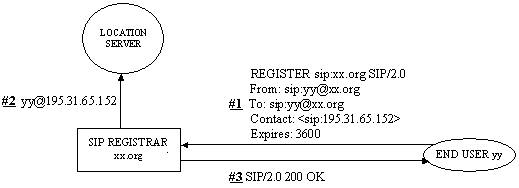While going through a typical SIP session you have already seen that the caller doesn't know the address of the callee initially. The proxy servers do the job of finding out the exact location of the recipient. What actually happens is that every user registers its current location to a REGISTRAR server. The application sends a message called REGISTER informing the server of its present location. The Registrar stores this binding (between the user and its present address) in a location server which is used by other proxies to locate the user.

User yy uses the IP 195.31.65.152 as its current location and registers it with the server. This actually helps in user mobility. Say there is a messaging application. You can log in from different computers. As soon as you log in using your username, the application REGISTER the username with the IP of that computer. The 'Expire' field reflects the duration for which this registration will be valid. So the user has to refresh its registration from time to time.
Please note that the difference between a proxy server and a registration or a location server is often only logical. Physically they may be situated on the same machine.
Wow!! You have completed the whole of the SIP tutorial. Congratulations! I insist that you go through the conclusion. It has important information to move forward in your SIP education.